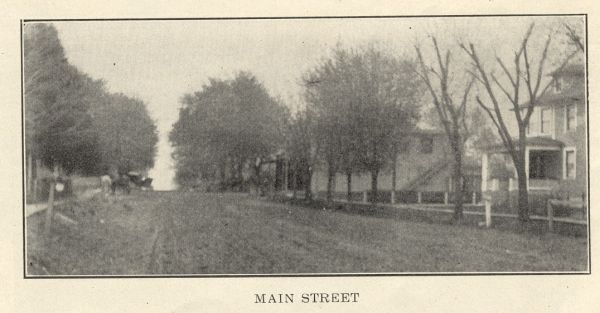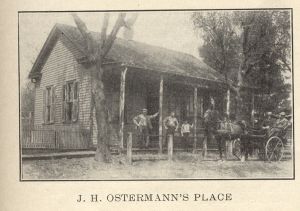|
Page 55 |
|
|
Jamestown is a pretty inland village, which was laid out by Wm. LENOX and James M. MASSEY, June 4, 1850, on the southwest quarter of section 2. LENOX afterward, in 1852, laid out an addition. On June 17, 1853, Wm. UZZELL laid out an addition of two blocks. He opened a store, and afterward took in Charles KANNE as a partner. They did business together some time and then dissolved partnership, and carried on two separate stores for many years. The post office was opened in 1861, Mr. Wm. UZZELL being the first post master. A watermill, east of Jamestown was operated many years ago. Prior to the platting |
J. H. OSTERMANN Mr. OSTERMAN is a manufacturer and dealer in blankets, lap robes, saddles, harness, whips and other goods for the horse and vehicle. He also does repairing of all kinds and makes a specialty of oiling harness, etc. He was born in St. Louis in 1888, and educated in the Benton school in that city. He learned the business of making harness under J. J. PHILLIPS, of St. Louis. Mr. OSTERMANN is also a barber and in 1912 bought out the interest and good will of L. G. HABBEGGER which was one of the oldest firms in the city. His business is increasing in both lines. He lives with his mother and two sisters in a fine residence near his place of business. He |
|
|
|
|
of Jamestown its site had already been inhabited; as early as 1818 William and John BRISBANE, two brothers from Tennessee built a cabin within the present limits of the village. Jamestown now contains a number of stores and business houses. Among the most prominent are:
|
has been located in the city for the past year and, judging from his present rate of increase in business, it is safe to say that within a few years he will have built up one of the finest business enterprises in the county. Samuel SENN Samuel SENN was born in Jamestown in 1865. He attended the FRICKER school near the little city and graduated from there with high honors. At the age of fifteen his father died and left him to take care of a family. He remained on the farm with his mother until at the age of 23, when he started out to do threshing for other people. In 1894 he sold out his threshing interests to George LEU and started into the butter making business. For seven years he continued at his work, being successful all the time. In 1901 he again went to threshing and in 1903 he took into partnership with him his brother, August. In 1905 he started his present business, a saw mill, in the southern part of Jamestown, which at that time was known as Cowford. Mill No. 1 is still located there. Last year he erected another mill in another part of the little city known as Goodingford and which is styled as mill No. 2. He also has a cider mill at Jamestown in which are hydraulic presses. This mill |
|
Page 56 |
|
|
was built in 1911. Mr. SENN sells hardwood lumber for ten miles around the city and does all kinds of commercial and custom sawing. He lives in a handsome eight-room residence, which has a modern lighting and heating plant,
and is one of the finest residences in the city. Mr. SENN is married and has a wife and three children to share his prosperity. R.J. FOEHNER Mr. FOEHNER was born in Jamestown, January 24, 1877. He was educated in the public school of the city and at the age of 15 began working for his father in the blacksmith business. He learned the trade thoroughly, and when his father died, in 1902, he took over the business |
Today he operates a model saw mill and is doing an excellent business. In 1898 he installed machinery for grinding purposes and does a general grist mill business in connection with his saw mill. His business is increasing every year. He was married in November, 1898, to Miss Louise HEDIGER. He lives in a fine home adjoining the saw mill and is one of the best known young men in the vicinity of Jamestown. He is very energetic
and progressive. The saw mill covers an area of 18X80 feet and is one of the largest buildings in the town. THE MOST VALUABLE SCENERY IS ROADSIDE SCENERY. It is a mistake to suppose that our greatest financial asset is something rare, remote and spectacular, like Niagara, Yosemite and Yellowstone. It is true that such |
|
|
|
|
and has conducted it successfully ever since. His father’s name was Fred FOEHNER, and he was one of the pioneer business men and settlers in Jamestown. Mr. FOEHNER also deals in implements and handles International, Kingman and Rock Island lines of farm machinery. He also does general blacksmithing, horse shoeing and repairing of all kinds. He was married November 18, 1900 to Miss Malda JUSTI, of Pocahontas, and has two children, both living. On December 1, 1912, he took into partnership with him Oscar ESSENPRIES, one of his employes. J. F. MEYER Mr. MEYER was born in Clinton county, January 21, 1872. For many years he attended the Beaver-Prairie Hull School and at the age of ten years, after school hours, began working for his father, assisting him in grinding feed and other work. At the age of 23, he started a saw mill in company with E. C. BURGISSER and in 1904 bought him out. |
things bring millions of tourists and will eventually add billions to our wealth, but the great bulk of the American people will live and die without ever seeing these vast, abnormal wonders. To the ninety million inhabitants of the United States, the most important scenery is the common, everyday, familiar scenery in which we pass our lives - what we see on our way from home to office. For the roadside scenery helps unconsciously to mold our national character. To realize this you need only to repeat to yourself any song by Sir Walter Scott or Robert Burns. Scotch life, poetry, and character are inextricably bound up with pine and heather, birch and rowan, gorse and bracken-rare to us, but familiar to every child in Scotland. Wheat in 1909 occupied 9.3 per cent of the total improved farm land and its value represented 12 per cent of the total for all crops. |
This file last modified




